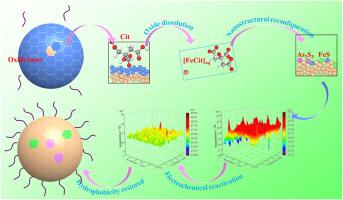Citric acid as a green rejuvenator: mechanistic insights into the complete recovery of floatability for oxidized arsenopyrite
IF 10
1区 环境科学与生态学
Q1 ENGINEERING, ENVIRONMENTAL
引用次数: 0
Abstract
The rehabilitation of oxidized arsenopyrite surfaces is critical for sustainable mineral processing. This study demonstrates that citric acid (CA) effectively restores arsenopyrite floatability by multi-mechanistic surface regeneration. XPS depth-profiling and TOF-SIMS results indicated that CA selectively chelation dissolved Fe3+-bearing oxides while competitively displacing re-adsorbed arsenate. This molecular selectivity reduced arsenic leaching by 55 % compared to H2SO4, owing to targeted complexation rather than indiscriminate proton attack. The results of electrochemical analysis, AFM and EDS analysis confirmed electrochemical reactivation initiating at surface asperities to enhance charge transfer and homogenization. HRTEM/SAED revealed nanostructure reconfiguration from epitaxial strained interfaces to functional polycrystalline domains enriched with FeS/As2S3 nanocrystals, facilitating S22− exposure. Consequently, CA achieved significant flotation recovery improvement while maintaining >80 % efficacy over 4–5 reuse cycles, pioneering a sustainable pathway for polymetallic sulfide ore rehabilitation.

柠檬酸作为绿色返老还老剂:氧化毒砂完全恢复可浮性的机理
氧化毒砂表面的修复是可持续矿物加工的关键。研究表明,柠檬酸(CA)通过多机制表面再生,可有效恢复毒砂的可浮性。XPS深度剖面和TOF-SIMS结果表明,CA选择性螯合溶解了含Fe3+的氧化物,同时竞争性地取代了再吸附的砷酸盐。与H2SO4相比,这种分子选择性减少了55%的砷浸出,这是由于有针对性的络合作用,而不是不分青红皂白的质子攻击。电化学分析、原子力显微镜和能谱分析的结果证实了在表面凹凸不平处引发的电化学再活化促进了电荷转移和均质化。HRTEM/SAED揭示了从外延应变界面到富含FeS/As2S3纳米晶体的功能多晶畴的纳米结构重构,促进了S22−暴露。因此,CA实现了显著的浮选回收率提高,同时在4-5个重复使用周期内保持80%的效率,开创了多金属硫化矿回收的可持续途径。
本文章由计算机程序翻译,如有差异,请以英文原文为准。
求助全文
约1分钟内获得全文
求助全文
来源期刊

Journal of Cleaner Production
环境科学-工程:环境
CiteScore
20.40
自引率
9.00%
发文量
4720
审稿时长
111 days
期刊介绍:
The Journal of Cleaner Production is an international, transdisciplinary journal that addresses and discusses theoretical and practical Cleaner Production, Environmental, and Sustainability issues. It aims to help societies become more sustainable by focusing on the concept of 'Cleaner Production', which aims at preventing waste production and increasing efficiencies in energy, water, resources, and human capital use. The journal serves as a platform for corporations, governments, education institutions, regions, and societies to engage in discussions and research related to Cleaner Production, environmental, and sustainability practices.
 求助内容:
求助内容: 应助结果提醒方式:
应助结果提醒方式:


